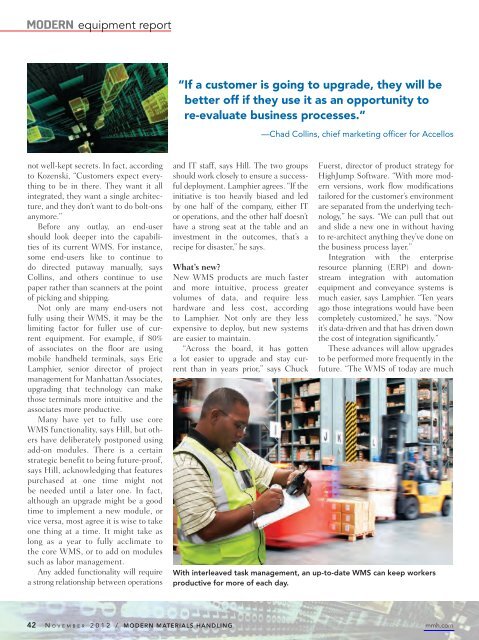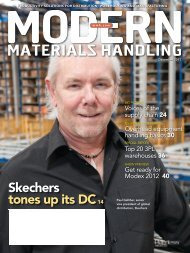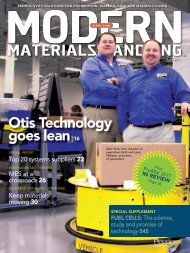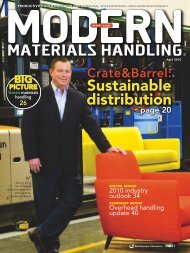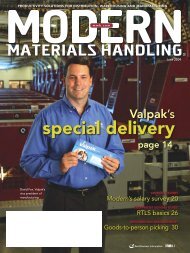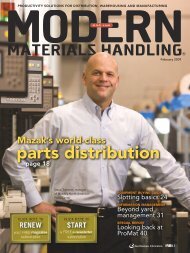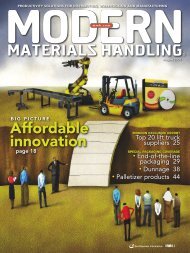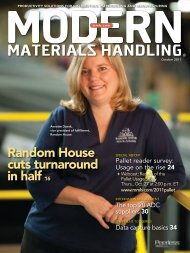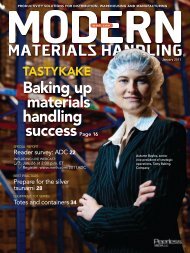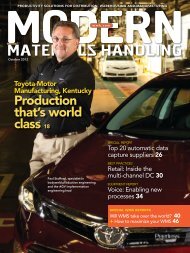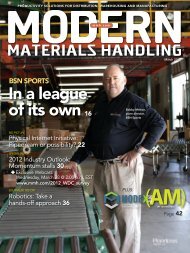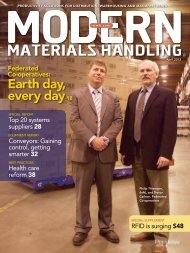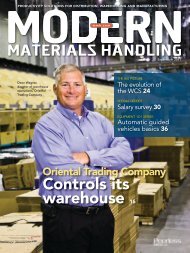Modern Materials Handling - November 2012
Modern Materials Handling - November 2012
Modern Materials Handling - November 2012
You also want an ePaper? Increase the reach of your titles
YUMPU automatically turns print PDFs into web optimized ePapers that Google loves.
MODERN equipment report“ If a customer is going to upgrade, they will bebetter off if they use it as an opportunity tore-evaluate business processes.”—Chad Collins, chief marketing officer for Accellosnot well-kept secrets. In fact, accordingto Kozenski, “Customers expect everythingto be in there. They want it allintegrated, they want a single architecture,and they don’t want to do bolt-onsanymore.”Before any outlay, an end-usershould look deeper into the capabilitiesof its current WMS. For instance,some end-users like to continue todo directed putaway manually, saysCollins, and others continue to usepaper rather than scanners at the pointof picking and shipping.Not only are many end-users notfully using their WMS, it may be thelimiting factor for fuller use of currentequipment. For example, if 80%of associates on the floor are usingmobile handheld terminals, says EricLamphier, senior director of projectmanagement for Manhattan Associates,upgrading that technology can makethose terminals more intuitive and theassociates more productive.Many have yet to fully use coreWMS functionality, says Hill, but othershave deliberately postponed usingadd-on modules. There is a certainstrategic benefit to being future-proof,says Hill, acknowledging that featurespurchased at one time might notbe needed until a later one. In fact,although an upgrade might be a goodtime to implement a new module, orvice versa, most agree it is wise to takeone thing at a time. It might take aslong as a year to fully acclimate tothe core WMS, or to add on modulessuch as labor management.Any added functionality will requirea strong relationship between operationsand IT staff, says Hill. The two groupsshould work closely to ensure a successfuldeployment. Lamphier agrees. “If theinitiative is too heavily biased and ledby one half of the company, either ITor operations, and the other half doesn’thave a strong seat at the table and aninvestment in the outcomes, that’s arecipe for disaster,” he says.What’s new?New WMS products are much fasterand more intuitive, process greatervolumes of data, and require lesshardware and less cost, accordingto Lamphier. Not only are they lessexpensive to deploy, but new systemsare easier to maintain.“Across the board, it has gottena lot easier to upgrade and stay currentthan in years prior,” says ChuckFuerst, director of product strategy forHighJump Software. “With more modernversions, work flow modificationstailored for the customer’s environmentare separated from the underlying technology,”he says. “We can pull that outand slide a new one in without havingto re-architect anything they’ve done onthe business process layer.”Integration with the enterpriseresource planning (ERP) and downstreamintegration with automationequipment and conveyance systems ismuch easier, says Lamphier. “Ten yearsago those integrations would have beencompletely customized,” he says. “Nowit’s data-driven and that has driven downthe cost of integration significantly.”These advances will allow upgradesto be performed more frequently in thefuture. “The WMS of today are muchWith interleaved task management, an up-to-date WMS can keep workersproductive for more of each day.42 N O V E M B E R 2 0 1 2 / MODERN MATERIALS HANDLING mmh.com


